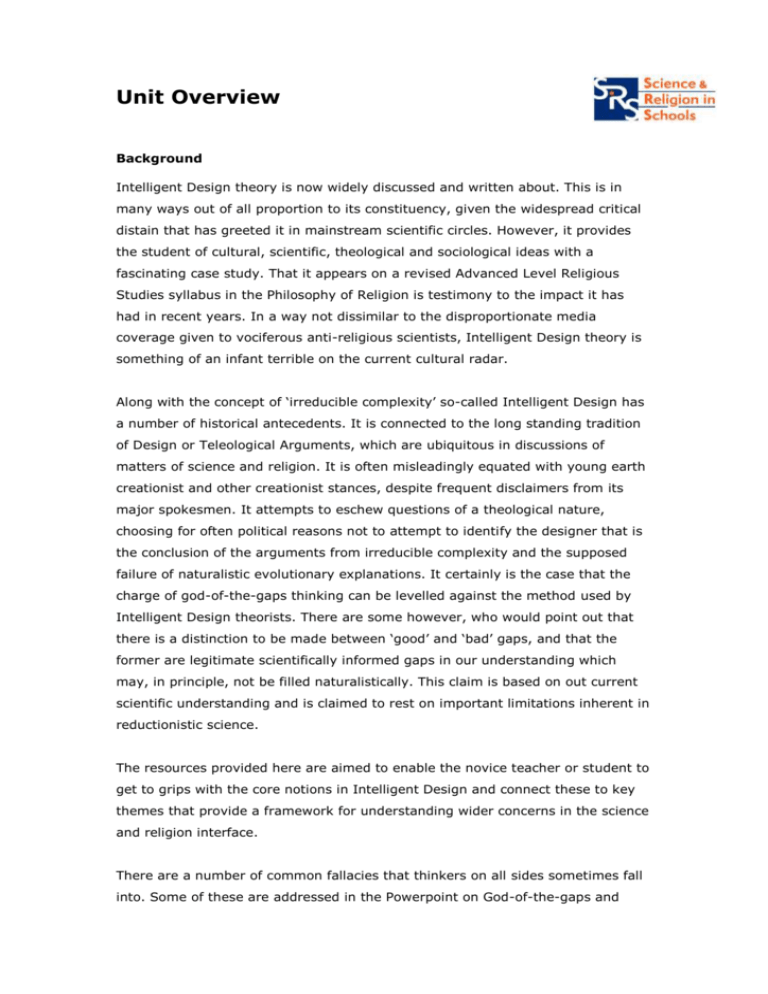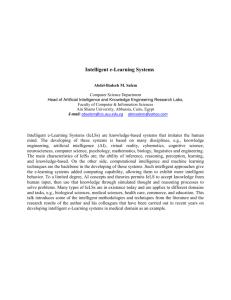Unit Overview - FaradaySchools
advertisement

Unit Overview Background Intelligent Design theory is now widely discussed and written about. This is in many ways out of all proportion to its constituency, given the widespread critical distain that has greeted it in mainstream scientific circles. However, it provides the student of cultural, scientific, theological and sociological ideas with a fascinating case study. That it appears on a revised Advanced Level Religious Studies syllabus in the Philosophy of Religion is testimony to the impact it has had in recent years. In a way not dissimilar to the disproportionate media coverage given to vociferous anti-religious scientists, Intelligent Design theory is something of an infant terrible on the current cultural radar. Along with the concept of ‘irreducible complexity’ so-called Intelligent Design has a number of historical antecedents. It is connected to the long standing tradition of Design or Teleological Arguments, which are ubiquitous in discussions of matters of science and religion. It is often misleadingly equated with young earth creationist and other creationist stances, despite frequent disclaimers from its major spokesmen. It attempts to eschew questions of a theological nature, choosing for often political reasons not to attempt to identify the designer that is the conclusion of the arguments from irreducible complexity and the supposed failure of naturalistic evolutionary explanations. It certainly is the case that the charge of god-of-the-gaps thinking can be levelled against the method used by Intelligent Design theorists. There are some however, who would point out that there is a distinction to be made between ‘good’ and ‘bad’ gaps, and that the former are legitimate scientifically informed gaps in our understanding which may, in principle, not be filled naturalistically. This claim is based on out current scientific understanding and is claimed to rest on important limitations inherent in reductionistic science. The resources provided here are aimed to enable the novice teacher or student to get to grips with the core notions in Intelligent Design and connect these to key themes that provide a framework for understanding wider concerns in the science and religion interface. There are a number of common fallacies that thinkers on all sides sometimes fall into. Some of these are addressed in the Powerpoint on God-of-the-gaps and although this goes beyond the topic of ID it provides another resource for the critical evaluation of things which are said by proponents and opponents. Aims of the topic At the end of the topic the most able students will have understood that: Intelligent Design is a concept which represents a range of views which at their core insist on the need for a designer or designers above and beyond a purported originator and sustainer of the evolutionary process. Irreducible Complexity is a key idea within Intelligent Design theory and they should be able to explain what it means and the way it is used to lead to the conclusion of an intelligent designer. There is a complex history to the movement with strands, which have their roots in theological, cultural and scientific matters. That there is sometimes a difference between the public perception of a movement and its own self-understanding. That the majority of informed scientists and theologians are cautious about the Intelligent Design programme, detecting in it something of the God-of-the-gaps error that has occurred in the history of thought. What is meant by God-of-the-gaps thinking. Some of the major participants in the Intelligent Design debate and the kind of things that they have said both for and against it. The inescapable impact of ones worldview on issues such as this. Some of the common fallacies that are common in discussions of science and religion. The fact that not all participants from a given worldview agree on the rights and wrongs of ID. In particular there are hermeneutical issues to do with the way in which sacred texts are used and understood which motivate some to approach the question of Intelligent Design in a particular way. The multi-disciplinary nature of a well balance understanding of this topic. Some will not have progressed this far but should have a basic grasp of the central issues presented in the material. At the very least they ought to be able to recall basic factual material. As always there will be differentiation based on the degree to which some go beyond this and show an ability not only to understand the material but to make an informed and nuanced evaluation of the same. Key Questions What is meant by Intelligent Design and Irreducible Complexity? What is God-of-the-gaps thinking? How do we place the ID question in a wider framework of understanding in order to be able to evaluate it? Learning Outcomes Students will understand: The meaning of ID and IC. What God-of-the-gaps thinking amounts to. How worldviews affect options in thinking about these issues. Something of the genesis of the ID movement and its motivation. The kind of evidence adduced by ID and the kind of objections levelled against it. Resources Resource Powerpoint 1 – Intelligent Design Resource Powerpoint 2 – God-of-the-gaps Resource Notes on Powerpoints Resource sheet 1 – Teacher introduction to ID Resource sheet 2 – Select resources Resource sheet 3 – Student introduction to ID Resource sheet 4 – Student comprehension / test Resource sheet 5 – Student comprehension / test answers Books See Resource sheet 2






